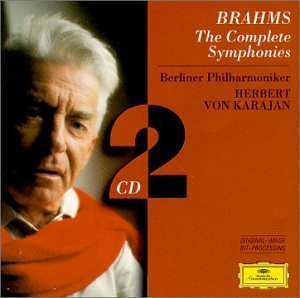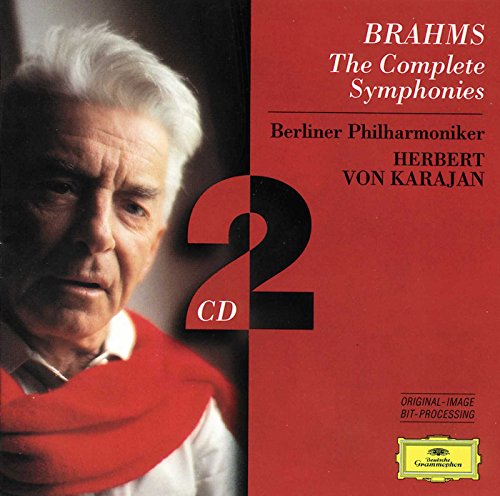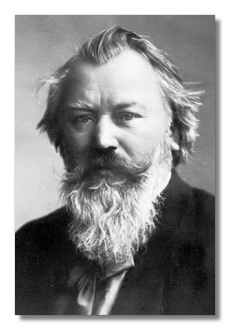高级会员

- 音乐币
- 13
- 贡献
- 10
- 金钱
- 2173
- 威望
- 0
- 相册
- 0
|
马上注册,结交更多好友,享用更多功能,让你轻松玩转社区。
您需要 登录 才可以下载或查看,没有帐号?注册

x
专辑中文名: Brahms: The Complete Symphonies艺术家: Johannes Brahms资源格式: MP3发行时间: 1998年07月09日地区: 德国简介:
IPB Image

IPB Image

专辑名称:Brahms: The Complete Symphonies
作 曲 家:Johannes Brahms (J·勃拉姆斯)
指 挥 家:Herbert von Karajan (H·卡拉扬)
演奏乐团:Berlin Philharmonic Orchestra (柏林爱乐管弦乐团)
专辑类别:古典音乐2CD
发行公司:Deutsche Grammophon
发行日期:June 9, 1998
音乐流派:Romanticism (1810-1910)
采 样 率:CBR 256
专辑介绍:
作为十九世纪最伟大的浪漫主义作曲家之一,勃拉姆斯的音乐无论是表达热情狂喜,还是悲哀忧郁的情绪都充满了内在的力量和真挚的情感,这种人性化的浪漫主义气质在他的交响乐中尤为突出。
勃拉姆斯的四部交响曲在古典音乐中占有非常重要的地位:第一部交响曲地完成就历经十五年的时间,这种极为严谨的创作态度和古典风范使他被人们尊为贝多芬精神上的继承人。这四部交响曲从沉重压抑的开篇经历一种内在的情感变化至恢宏不朽的终篇。(关于四部交响曲较详细的创作背景,请点击)
卡拉扬与柏林爱乐乐团录制于1977-78的版本被认为是他个人的最佳版本,尽管也有人认为没有超越他60年代的录音版本(偶没有听过,还无从比较)。
These 1977-78 recordings are Karajan s best Brahms--better than his somewhat mannered digital set. The Berlin Philharmonic, as ever, is amazingly smooth and accomplished, playing with great class without losing any power--as an example, just listen to the finale of the second symphony. DG s engineers have turned this always-good recording into something truly magnificent to hear, and, at the price, this is a sure bet. --Robert Levine
专辑曲目:
Disc: 1
1. Symphony No. 1 In C Minor Op. 68: 1. Un poco sostenuto - Allegro
2. Symphony No. 1 In C Minor Op. 68: 2. Andante sostenuto
3. Symphony No. 1 In C Minor Op. 68: 3. Un poco Allegretto e grazioso
4. Symphony No. 1 In C Minor Op. 68: 4. Adagio - Piu Andante - Allegro non troppo, ma con brio
5. Symphony No. 3 In F Major op.90: 1. Allegro con brio
6. Symphony No. 3 In F Major op.90: 2. Andante
7. Symphony No. 3 In F Major op.90: 3. Poco Allegretto
8. Symphony No. 3 In F Major op.90: 4. Allegro
Disc: 2
1. Symphony No. 2 In D Major Op. 73: 1. Allegro non troppo
2. Symphony No. 2 In D Major Op. 73: 2. Adagio non troppo - L istesso tempo, ma grazioso
3. Symphony No. 2 In D Major Op. 73: 3. Allegretto grazioso (Quasi Andantino) - Presto ma non assai - Tempol
4. Symphony No. 2 In D Major Op. 73: 4. Allegro con spirito
5. Symphony No. 4 In E Minor Op. 98: 1. Allegro non troppo
6. Symphony No. 4 In E Minor Op. 98: 2. Andante moderato
7. Symphony No. 4 In E Minor Op. 98: 3. Allegro giocoso - Poco meno presto - Tempo l
8. Symphony No. 4 In E Minor Op. 98: 4. Allegro enerico e passionato - Piu Allegro
# 专辑仅用于试听, 请购买正版支持你欣赏的音乐家 #
作曲家介绍:
IPB Image

Johannes Brahms (born Hamburg, 7 May 1833; died Vienna, 3 April 1897).
He studied the piano from the age of seven and theory and composition (with Eduard Marxsen) from 13, gaining experience as an arranger for his father s light orchestra while absorbing the popular alla zingarese style associated with Hungarian folk music. In 1853, on a tour with the Hungarian violinist Reményi, he met Joseph Joachim and Liszt; Joachim, who became a lifelong friend, encouraged him to meet Robert Schumann. Brahms s artistic kinship with Robert Schumann and his profound romantic passion (later mellowing to veneration) for Clara Schumann, 14 years his elder, never left him. After a time in Düsseldorf he worked in Detmold, settling in Hamburg in 1859 to direct a women s chorus. Though well known as a pianist he had trouble finding recognition as a composer, largely owing to his outspoken opposition - borne out in his d Minor Piano Concerto op.15 - to the aesthetic principles of Liszt and the New German School. But his hopes for an official conducting post in Hamburg (never fulfilled) were strengthened by growing appreciation of his creative efforts, especially the two orchestral serenades, the Handel Variations for piano and the early piano quartets. He finally won a position of influence in 1863-4, as director of the Vienna Singakademie, concentrating on historical and modern a cappella works. Around this time he met Wagner, but their opposed stances precluded anything like friendship. Besides giving concerts of his own music, he made tours throughout northern and central Europe and began teaching the piano. He settled permanently in Vienna in 1868.
Brahms s urge to hold an official position (connected in his mind with notions of social respectability) was again met by a brief conductorship - in 1872-3 of the Vienna Gesellschaftskonzerte - but the practical demands of the job conflicted with his even more intense longing to compose. Both the German Requiem (first complete performance, 1869) and the Variations on the St. Antony Chorale (1873) were rapturously acclaimed, bringing intemational renown and financial security. Honours from home and abroad stimulated a spate of masterpieces, including the First (1876) and Second (1877) Symphonies, the Violin Concerto (1878), the songs of opp.69-72 and the C major Trio. In 1881 Hans von Bülow became a valued colleague and supporter, lending Brahms the fine Meiningen court orchestra to rehearse his new works, notably the Fourth Symphony (1885). At Bad Ischl, his favourite summer resort, he composed a series of important chamber works. By 1890 he had resolved to stop composing but nevertheless produced in 1891-4 some of his best instrumental pieces, inspired by the clarinettist Richard Mühlfeld. Soon after Clara Schumann s death in 1896 he died from cancer, aged 63, and was buried in Vienna.
Fundamentally reserved, logical and studious, Brahms was fond of taut forms in his music, though he used genre distinctions loosely. In the piano music, for example, which chronologically encircles his vocal output, the dividing lines beteen ballade and rhapsody, and capriccio and intermezzo, are vague, such terms refer more to expressive character than to musical form. As in other media, his most important development technique in the piano music is variation, whether used independently (simple melodic alteration and thematic cross-reference) or to create a large integrated cycle in which successive variations contain their own thematic transformation (as in the Handel Variations).
If producing chamber works without piano caused him difficulty, these pieces contain some of his most ingenious music, including the Clarinet Quintet and the three string quartets. Of the other chamber music, the eloquent pair of string sextets, the serious C minor Piano Quartet op.60 (known to be autobigraphical), the richly imaginative Piano Quintet and the fluent Clarinet Trio op.1l4 are noteworthy. The confidence to finish and present his First Symphony took Brahms 15 years for worries over not only his orchestral technique but the work s strongly Classical lines at a time when programmatic symphonies were becoming fashionable; his closely worked score led him to be hailed as Beethoven s true heir. In all four symphonies he is entirely personal in his choice of material, structural manipulation of themes and warm but lucid scoring. All four move from a weighty opening movement through loosely connected inner movements to a monumental finale. Here again his use of strict form, for example the ground bass scheme in the finale of the Fouth Symphony, is not only discreet but astonishingly effective. Among the concertos, the four-movement Second Piano Concerto in B-flat - on a grandly symphonic scale, demanding both physically and intellectually - and the Violin Concerto (dedicated to Joachim and lyrical as well as brilliant) are important, as too is the nobly rhetorical Double Concerto.
Brahms s greatest vocal work, and a work central to his career, is the German Requiem (1868) combining mixed chorus, solo voices and full orchestra in a deeply felt, non-denominational statement of faith. More Romantic are the Schicksalslied and the Alto Rhapsody. Between these large choral works and the many a cappella ones showing his informed appreciation of Renaissance and Baroque polyphony (he was a diligent collector, scholar and editor of old music) stand the justly popular Zigeunerlieder (in modified gypsy style) and the landler-like Liebeslieder waltzes with piano accompaniment. His best-loved songs include, besides the narrative Magelone cycle and the sublime Vier ernste Ges auml;nge, Mainacht, Feldeinsamkeit and Immer leiser wird mein Schlummer.
Extracted with permission from The Grove Concise Dictionary of Music
edited by Stanley Sadie
Macmillan Press Ltd., London.
下载地址:
|
|
 |小黑屋|手机版|Archiver|版权声明|001科技|
音乐吧 52290
( 桂ICP备2021006182号 )
|小黑屋|手机版|Archiver|版权声明|001科技|
音乐吧 52290
( 桂ICP备2021006182号 )